Eggs of Frogs and Aquatic Salamanders in Calfornia
Click on a picture for a larger view

| I don't have pictures of all of the eggs of amphibians native to California, but I will show those I do have here, in hope that it might make them easier to identify and compare with the eggs of other sympatric amphibians. If you have pictures of eggs not shown here that you can positively identify and would like to contribute, please let me know, they will be very much appreciated. For pictures and information about the amphibians, click on the name links. |
||
| Aquatic Salamander Eggs | ||
| Salamander eggs that are laid in water have a layer of jelly around the ova. This jelly is to protect them from predators and from the elements since the eggs float exposed in water until they hatch. The young hatch into an aquatic larval form where they develop and grow in the water, breathing through gills, until they are ready to transform into their terrestrial form and breathe through lungs. Occasionally, they do not transform but remain in the water as gilled adults. | ||
| California Tiger Salamander - Ambystoma californiense These are similar to the eggs of Western Tiger Salamander - Ambystoma mavortium | ||
Eggs are laid individually and attached to stems or other objects underwater, then abandoned. Egg deposition occurs after the first heavy rains fill the breeding ponds, typically November - January. |
||
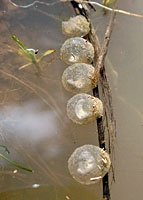 |
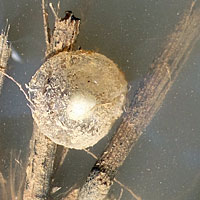 |
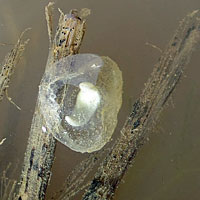 |
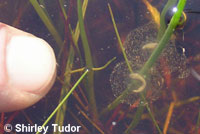 |
 |
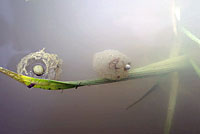 |
| Northwestern Salamander - Amybstoma gracile | ||
The female lays 30 - 270 eggs in masses that are roughly the size of a small grapefruit , and attach them to underwater shrub branches, grass, or aquatic plants, then abandons them. Eggs are laid between January and April in low-elevation areas, June to August at higher elevations. |
||
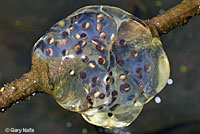 |
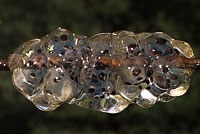 |
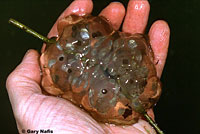 |
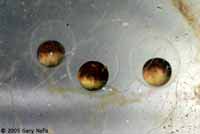 |
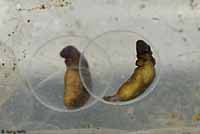 |
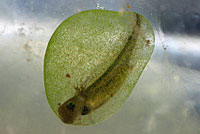 |
| Close-up of freshly laid eggs | Close-up of developing embryos | Developing embryo, ready to hatch. The eggs often support the growth of algae inside the inner jelly layer. |
| Southern Long-toed Salamander - Ambystoma macrodactylum sigillatum
Santa Cruz Long-toed Salamander - Ambystoma macrodactylum croceum |
||
The eggs shown below are from a subspecies of Long-toed Salamander found north of California, the Western Long-toed Salamander, Ambystoma mactodactylum macrodactylum, but the eggs of all Long-toed Salamander subspecies should look the same. In spring (or in early summer at higher elevations) Females lay from 90 - 400 eggs in small masses containing from 1 - 81 eggs in shallow water, attaching them singly or in loose clusters to the undersides of logs and branches, or leaving them unattached on the bottom, then abandons them. Santa Cruz Long-toed Salamanders breed during the winter rainy season, typically in January and February. |
||
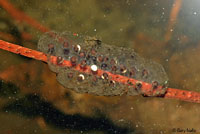 |
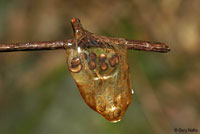 |
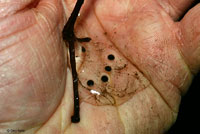 |
| California Giant Salamander - Dicamptodon ensatus Coastal Giant Salamander - Dicamptodon tenebrosus |
||
In spring, typically in May (later at higher elevations) the female deposits her entire clutch of 135 - 200 eggs singly, side-by-side, on the roof of the nest chamber, which is typically a large log or rock submerged in a creek, then she stays with the eggs to guard them until they hatch. The picture of Dicamptodon tenebrosus eggs in Jones et al., Amphibians of the Pacific Northwest, 2005, shows them as well-separated individual white dots on the bottom of a large rock. |
||
| Southern Torrent Salamander - Rhyacotriton variegatus | ||
Little is known about this salamander's seasonal breeding habitat. Single, loosely laid, pigmentless eggs are laid in flowing water and abandoned. Clutches of 8 and 11 eggs have been found beneath rocks in streams with gravel substrates. |
||
| Rough-skinned Newt - Taricha granulosa |
||
From March to April at low elevations through summer at higher elevations, the female lays tiny eggs individually and attaches them to underwater vegetation or debris, then abandons them. |
||
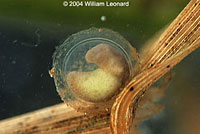 |
||
| Egg on submerged blade of grass, Thurston County, Washington. © 2004 William Leonard |
||
| Red-bellied Newt - Taricha rivularis | ||
From February to May, with a peak in March, the female lays and attaches a flattened egg mass containing about 10 eggs under stones in the middle of a creek or under rocks overhanging the creek, or onto submerged roots, then abandons them. Many egg masses are sometimes found under one stone. |
||
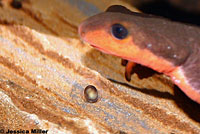 |
 |
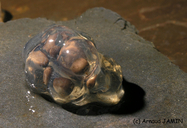 |
| Adult newt and single egg, Mendocino County © Jessica Miller |
Eggs, Sonoma County. © 2008 Arnaud Jamin. From the CalPhotos collection. | |
| Sierra Newt - Taricha sierrae | ||
In early Spring the female lays a spherical egg mass about one inch or less in diameter containing from 7 - 47 eggs to the sides and bottoms of stones and sticks in relatively fast-flowing water, then abandons them. Egg masses are attached just below the surface of the water. |
||
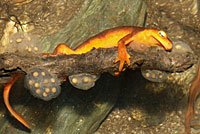 |
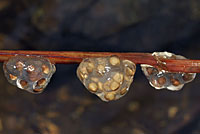 |
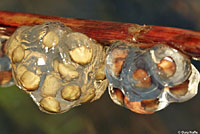 |
| California Newt - Taricha torosa | ||
In winter and spring the female lays a spherical egg mass about one inch or less in diameter containing from 7 - 47 eggs and attaches them to submerged vegetation, branches, or rocks, then abandons them. Egg masses from many females often occur in clusters. |
||
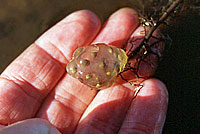 |
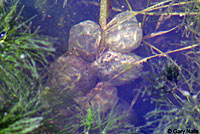 |
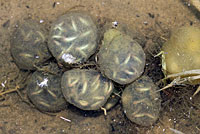 |
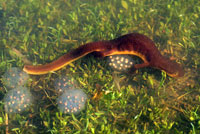 |
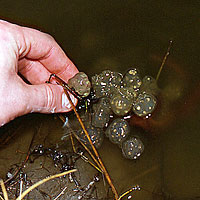 |
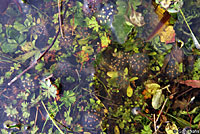 |
| Frog Eggs | ||
| Terrestrial Salamander Eggs | ||
| Things Mistaken For Amphibian Eggs | ||
Return to the Top
© 2000 -
